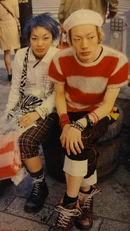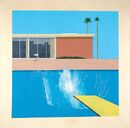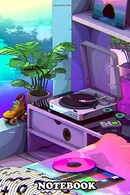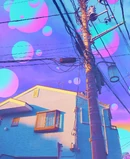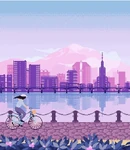City Pop (シティーポップ) is an old genre of Pop music from Japan. It began in the mid-1970s, rising to the peak of its popularity in the late-1970s and early-1980s. It also spread to other areas of Asia, particularly establishing a foothold in Hong Kong, where many covers of popular City Pop songs were popularized in Cantopop.
It is also considered a predecessor to modern J-Pop (though it certainly has more of a sophisticated vibe to it compared to modern J-Pop). Various City Pop songs are sampled in many Future Funk songs. Famous City Pop artists include, Mariya Takeuchi, Taeko Onuki, Miki Matsubara, Anri, Naoko Gushima, Tatsuro Yamashita, Junko Yagami, etc.
Much of City Pop was also influenced by 80s Japanese New Wave artists, such as YMO, Akiko Yano, Ippu-Do, and Sandii and the Sunsetz. All of these artists worked with members of Japan, the British New Romantic band, who also experimented with and influenced City Pop. (A few other British artists in this genre include Virginia Astley and The Dolphin Brothers.)
There are many City Pop compilations on YouTube for people to listen to, with channels such as Ganymede Cafe making 40 minute long compilations of City Pop songs. Many of these songs are played in the background of an old anime GIF on loop. City Pop is considered an aesthetic genre of music due to its casual and upbeat nature.
Despite the best years of City Pop being behind the genre, the spirit of it lives on as sometimes it'll be interspersed with Vaporwave (and a lot of Vaporwave artists will sample City Pop in their songs to invoke the imagery of sophisticated Japan on the rise in the 80's and 90's) and a lot of City Pop aesthetics will find themselves tied to the Lo-Fi aesthetic, thus ensuring City Pop's legacy in internet aesthetic history.
History[]
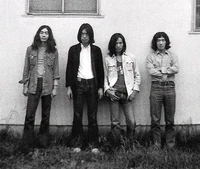
Members of Happy End
City pop has its origins in the Folk bands of the early 1970s. The folk rock band Happy End is often considered the foundation of City Pop.[1]
Visual[]
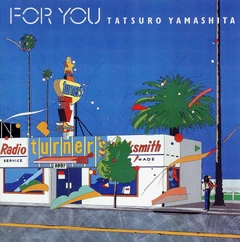
For You - Tatsuro Yamashita
A lot of City Pop images depict shots of opulent city life and high nightlife; hence the name. Many of these images are taken from tropical locations like California and Hawaii, featuring oceans, beaches, and palm trees. These images are often stylistically edited to show more pops of magenta, cyan, red, yellow, blue, and Purple.
Architecture is a common element depicted within the aesthetic, particularly pools and Modernist houses. City streets, skylines, and beaches are also prominently featured in city pop. Typically, these streets will be empty and peaceful with nobody around except a vintage vehicle (giving a similar vibe to the After Hours aesthetic).
Fashion[]
Clothing[]
City Pop fashion tends to be very opulent, high end, and draws a lot on the Yuppie fashion of the time (and so a lot of J-Preppy and Resort style turns up in City Pop fashion). Indeed, a lot of City Pop fashion has served as inspiration for a lot of modern Japan-inspired aesthetics such as Vaporwave and Lo-Fi. "Business Casual" is a popular phrase in City Pop fashion. Later City Pop music from the mid-to-late 1980s also draws a lot of inspiration in its female fashion from the then-emerging Bodikon subculture.
Sailor Moon and California Crisis anime are prime examples of City Pop outfits.
Typical City Pop fashion items include:
- Dress shirts
- Polo or rugby shirts
- Knee-length khaki shorts or long pants
- Shiny dress shoes
- Sweaters, sweater vests, cardigans, or other woven tops
- Pleated skirts
- Muumuus or sundresses
- Black or white jeans
- Scarves
- Suspenders
- Hair accessories such as bobby pins, clips, bows, ties
- White socks, knee-length or regular
- Bracelets or bangles
*can be worn in neon or loud colours/patterns
Wearing City Pop motifs (cities in neon colours, cassettes, soda or strawberry milk cans, occasionally flamingos, etc.) can also be considered a less casual and/or more modern subset of City Pop fashion.
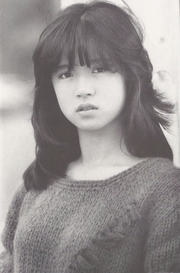
A typical City-Pop women's hairstyle.
Hair[]
Hairstyles are reflective of the era, but simultaneously have a wide range.
In women's hairstyles, common characteristics include voluminousness, curliness, and heavy application of products like hairspray and dry texturising spray. These include:
- Shoulder-length, wavy or curly with blunt/parted bangs
- Past-shoulders, wavy or curly with blunt/parted bangs
- Shoulder-length, wavy, curly, or crimped with blunt/parted bangs
Men's hairstyles are similar to women's hairstyles, being long and voluminous
- Shoulder-length with middle part
Music[]
City Pop's musical style is heavily influenced by American soft rock (namely acts such as Steely Dan and The Doobie Brothers) by taking the song structures of the genre and mixing it with Southern R&B from the US, Northern Soul from the UK, and jazz fusion music to try and achieve an almost tropical and sophisticated sound (drawn heavily from the Hawaiian and Okinawan vibes in particular) born from the belief that the Japanese economy was only going to continue to thrive and grow and that the good times would never end (much like America's Roaring Twenties).
The music in particular was also designed specifically to play in car stereos of the time (which were just starting to gain popularity), which was a very unique idea at the time.
Influence[]
While City Pop faded out of style in Japan after the late 1980's, largely due to the tanking of the Japanese economy in what came to be known as "The Lost Decade" (that Japan arguably still hasn't completely recovered from), the genre went on to spread to the nearby Hong Kong as Cantopop artists made covers of Japanese City Pop songs until the 1990s.

竹内まりや - Plastic Love (Official Music Video)
Probably the most well-known example of City Pop to the internet at large.
In the 2010's, City Pop has seemingly found new life thanks to edits of it being featured in Vaporwave and Future Funk. Future Funk artists in particular, such as MACROSS 82-99, tend to love to sample old City Pop songs and transforming them into funky new tracks. Classic City Pop also gained popularity around this time due to the fact the YouTube algorithm at one point decided to pick Mariya Takeuchi's "Plastic Love" to be the random video that turns up in everybody's feed to watch, which led to the song getting so popular that they decided to film a (new) music video for the song 35 years after its initial release!
Many anime fans from the 90's (when anime was just starting to take off in the West) might actually recognize a lot of popular City Pop artists due to a lot of the artists doing the themes for various anime that came out in the 80's and early 90's and the themes themselves generally carry a slight City Pop sound.
The spiritual successor of City Pop, Shibuya-kei, is a microgenre of pop music or a general aesthetic that flourished in the mid to late 1990s. Shibuya-kei initially fused French yé-yé, jazz, bossa nova, lounge music, funk, and 60's psychedelic pop into a futuristic retro-pastiche.
Resources[]
External links to help get a better understanding of this aesthetic.
Playlists[]
- 鮮やかな真夜中 A Japanese Pop Playlist by Mrspec1
- 80s japanese city pop by Rainbeary
- 80s japanese pop (j-pop) by マガラ
- 70s 80s 90s Japanese Funk/Soul/City pop by マガラ



